[Hand of P. O'Keeffe:]
Sir,
On Monday 12th Inst. I visited the Parish of Beagh situated in the Southern extremity of the Barony of Kiltartan; it is called in Irish by the people Beitheach {gen: na beithíghe} which means "a place abounding in birch".
The ruin of the old church of Beagh (which) stands in a very stony district in the Townland of the same name measures about 63 feet in length, and 18½ (18ft. 4inches.) in breadth; height of the walls about 10 feet. The doorway, which is situated on the S. side-wall, the inner part being about 10ft. 7inches, from the W. gable, is about 6ft. 1in. high, 3ft. 3½in. wide above, and 3ft. 5½in. wide immediately above the 2 lower stones; but the shape of the bottom stone on the E. side reduces the width to about 3ft. 43/4in. It presents this appearance outside
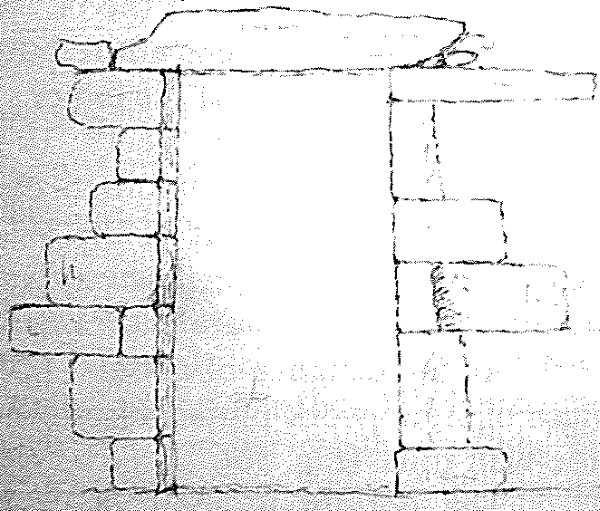
The outer part is lf. 2in. thick; the inner part which is about 5½ inches wider on each side, is about lft. 8in. thick making the entire thickness of the wall 2ft. 10inches
In the middle of the same S. wall is a window about 3ft. + high and 5 inches wide outside, but widening considerably within, where it presents this appearance
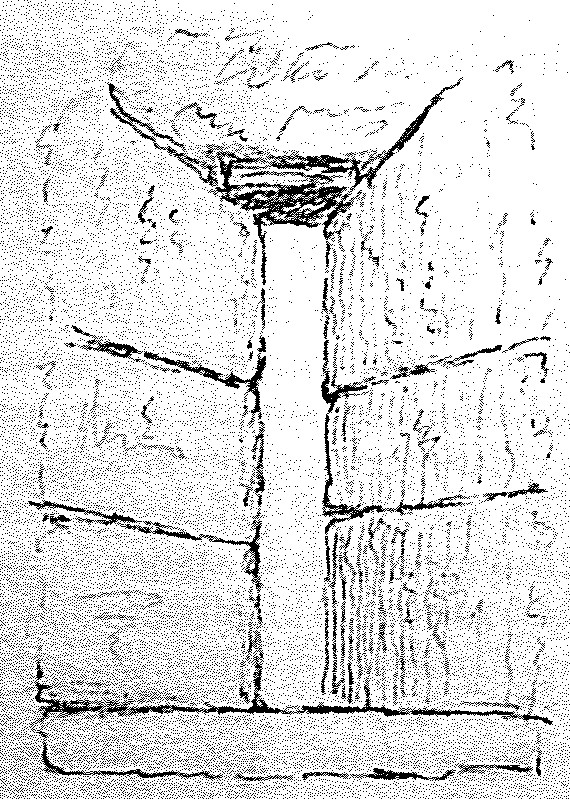
On the same wall about 7 feet from the outside of the E. gable (there is a window) 3ft. 3in. in height and 5½ wide; thus {wide inside}
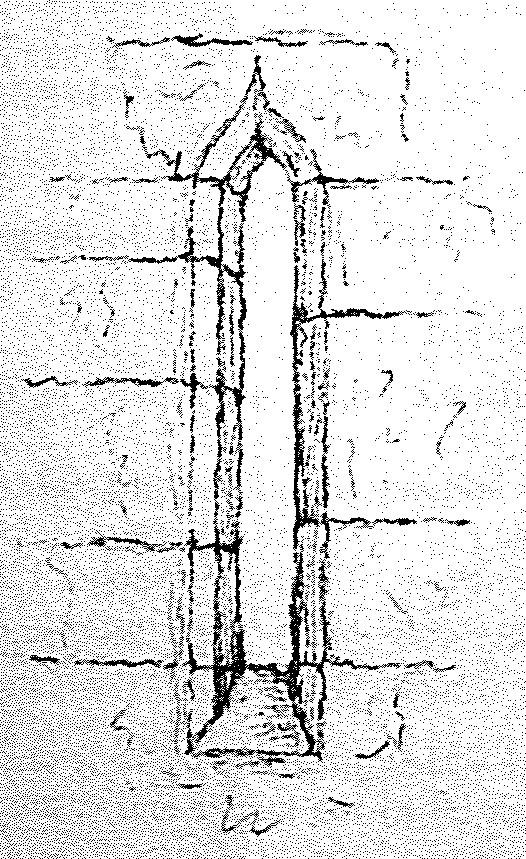
On the E. gable is a window about 5ft. high and about 5 inches wide outside, where it is shaped thus at the top  the vertical angle being obtuse; the inside widens as with the two other windows here mentioned. There is a breach on the N. side wall near the East;
the vertical angle being obtuse; the inside widens as with the two other windows here mentioned. There is a breach on the N. side wall near the East;
the W gable is entire but featureless.
The average size of the larger stones in (of) the building is about lft. 9in. or 1ft. 10in. by 12 inches, among which are mixed up others of smaller size; the stones on the upper part of the W. gable are much smaller, and those on the Eastern part of the N. wall, are rather small. They are laid rather regularly.
At the distance of about 11½ft. from the E. a piece of stone-work projects from the (outside of) S. side-wall thus.
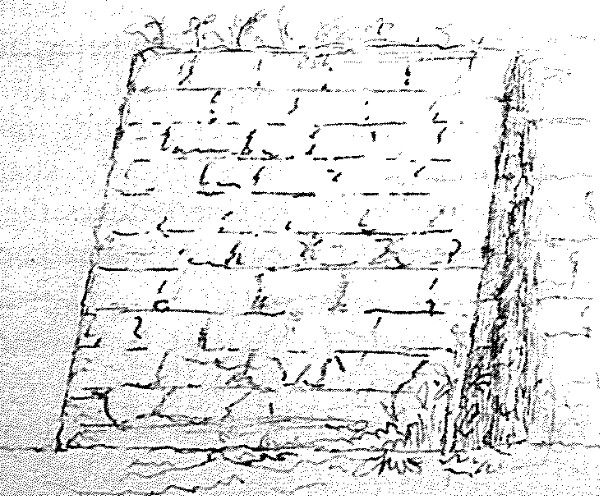
The bottom is about 5 or 6 feet from the Church wall; the front is about 9 - 9 in length and meets the S. wall above, where it is somewhat narrower (shorter). The only aperture is a breach on the Eastern part adjoining the church wall. It would appear to have been hollow, but at present is nearly filled up with stones. On the same S. side- wall adjoining the W gable is a similar projection of nearly the same dimensions; the western part of which is continuous with that gable, the western edge of the front being a continuation of
the upper line of the gable:
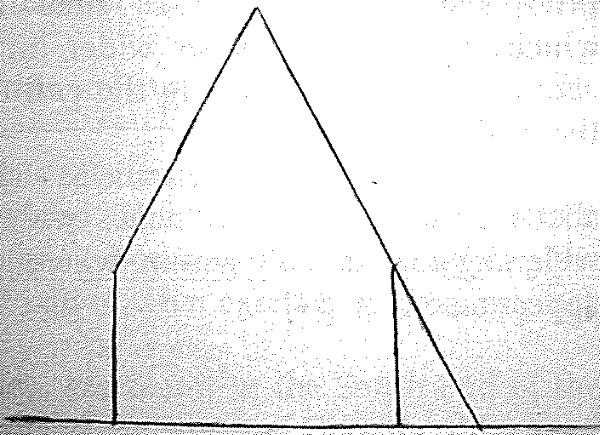
The stones of this addition are of smaller size than those of that part of the gable adjoining, but are similar to the stones of the upper part of it, and (to those) of other parts of the building.
The district in which this church is situated, wonderfully abounds in stones, so that the graves of the dead are here filled up with those materials, which are arranged above in the form usually given to graves of earth.
I have been informed that the Patron-day of the Parish is (was) S. Anne's day, which the people think falls on the 24th of July; this can be easily ascertained.
Beagh is set down among the possessions of the Earls of Clanrickard in an
Inquisition taken at Galway, 20th March 1608, before Geoffrey Osbaldstone Esqre. {and others) by the oathes of lawful men who say that ***
{abstr} Rickard 2nd Earl died, and Ulick Bourke, third Earl son and heir to said Rickard, entered into his possessions and was thereof seized. ***
That it was found by an Inquisition taken before John Crofton Esqre. at Athenry 1st October 1584 that said Rickard late Earl died 24th July 1582 seized in fee taile of the several lands following viz. *** {inter alia} the Towne of Beagh {4 q.} Layragh {4 q.} the ruinous Castle of Loghcowtra within an island in the Logh aforesaid, &c &c &c ***
And that said (Earl) Ulick {'father of the now Earl'} was likewise seized in fee and fee tayle of the lands hereafter, viz: *** the manor and castle of Clare {& 6 q.} Beagh {4 q.} the manor and castle of Corrofinny, &c &c &c
The ruins of the old castle of Lough cooter still remain, situated in an island in the lake (lough) of that name, called Castle Island {Oileán a' Chaislean} in this Parish.
In the townland of Lough cooter Demesne ({Beagh Ph.}) which adjoins this Lough is situated the mansion of Lord Gort, called Loughcooter Castle.
Loch Cutra is mentioned in the Annals of the Four Masters at the year 1601.
{It is stated that Redmond Burke being at war with the Earl of Clanrickard, (continued) plundering the territory of Kenel-feichin "to the South of the Barony of Leitrim", until the Earl of Clanrickard arrived and pitched his camp at the Monastery of Kenel-feichin.}
Thus they {i.e. the Earl and Redmond} remained for four or five days {during which time some persons of low rank were slain on both sides,} until Teige, the son of Brian na murtha, who was son of Brian Ballach, who was son of Owen O'Rourke, arrived with a number of bold and well armed troops to assist Redmond. Whan the Earl perceived that these two parties were united against him, he left his camp and passed into Clanrickard. The others pursued him as far as Loughreagh; and because the Earl and his people effected their escape from them on this occasion, they traversed, plundered and burned the country from Leitrim to Ard-Maoldubhain (Ard-Maoldubhain locally pronounced Ard a Mhaolubháin is a T.L. in Beagh Ph.), and as far as the gate of Feadan (angl. Fiddan, a Townland in the same Ph. in which stands the ruined walls of an old Castle. Beagh Ph. lies in the S.W. of the district anciently called Cinéal Aodha na h-Eohtghe, adjoining the Co Clare {Thomond}) in the west of Kinel Aodha.
When Redmond arrived with his bands on the frontiers of Thomond, he pitched his camp at the western side of Lough Cutra, where he was joined by a nobleman of the Dalcassians, Teige, {the son of Torlogh, who was son of Donall, who was son of Conor) O'Brien, who had adopted this step in compliance with the advice and solicitations of bad and foolish men, and without consulting or taking counsel of his father or the Earl of Clanrickard who was his Kinsman and friend. Here he entered into a confederacy with the sons of John Bourke, and in the course of three days afterwards requested them to accompany him on an excursion into some part of Thomond. This request was not refused, for he was accompanied by some of the chiefs from the Camp with their Kerns. &c &c &c
In O'Flaherty's Ogygia Part III. Chap. XI. transl. vol II p. 21. we read:
Besides we are told, that the Belgians gave names to those places in the environs of Galway, Loughkime, Rinntamuin, in Medrigia, Loughcutra, Rinnmbeara, Molinn and Carn conuill in Aidhne.
In the townland of Killeen there is a holy well called Tobar Mochoille, erroneously called in the name-book Tobermahawleel, the last syllable being a clerical error for lue as can be inferred from the fact that at the T.L. Boolafaudeen {Buaile Pháidín} it is stated that "Tobermahawlue Holy well is in this townland". Tobermahawlue is an attempt at representing the Irish sound. Those whom I have consulted say there is not a second Tobar Mochoille in the Ph. that in Killeen being the only one.
In Rathwilladoon T.L. {Ráth Mhaoiledúin) there is a holy well called Tobar Righ an Domhnaigh .i. the well of the King of Sunday, at which stations were (are) performed on (any) Sunday the pilgrim might choose.
P. O'Keeffe.
